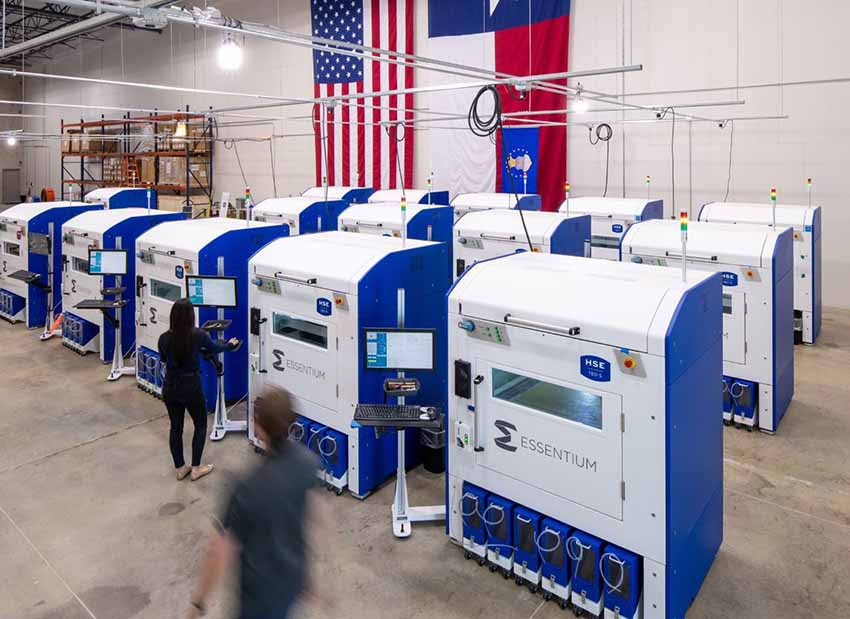Essentium is an industrial 3D printing company that provides high-performance materials, hardware, and software solutions to the manufacturing industry. Their goal is to empower manufacturers to realize the full potential of additive manufacturing by providing reliable, scalable, and cost-effective solutions.
Interview with Blake Teipel, Ph.D., CEO of Essentium.
Easy Engineering: What are the main areas of activity of the company?
Blake Teipel: The main areas of activity for Essentium include developing and manufacturing industrial-grade 3D printers, producing high-performance materials for 3D printing, and offering comprehensive software solutions for managing 3D printing operations. Essentium has partnered with customers, such as U.S. Air Force, Mercury Systems, Braskem, and VirTex, to enable the optimal use of materials, technology, and processes.
E.E: What’s the news about new products?
B.T: Essentium is committed to meeting the evolving needs of the manufacturing industry by constantly innovating and developing new products. Our latest products showcase our dedication to providing reliable and efficient solutions for industrial 3D printing. The Essentium High Speed Extrusion (HSE™) 280i HT 3D Printer is designed for the demands of the factory floor. It features independent dual extruders, enabling manufacturers to speed up the production of complex parts while significantly reducing post-processing costs. The Essentium HSE 240 HT 3D Printer is a high-performance printer that can create highly accurate parts from different materials in a single print. We also recently introduced PPS-CF, a cost-effective material with exceptional strength and resistance suitable for various challenging applications. At Essentium, we are constantly pushing the boundaries of what is possible with industrial 3D printing, and we are excited to continue developing innovative solutions for our customers.

E.E: What are the ranges of products?
B.T: Our product range includes industrial 3D printers, high-performance materials, and software solutions for managing 3D printing operations.
Our printers include:
- Essentium HSE 280i HT 3D Printing Platform: the first industrial 3D printer featuring true independent dual extruders (IDEX) in which each head is fully independent on both the X and Y axis.
- Essentium HSE 180 3D Printing Platform: At five to 15x faster than the competition, this printer is built to transform the factory floor. Using an X-Y stage with all linear servo motors, the HSE 180 3D Printer you can finally harness the power of 3D printing at scale without sacrificing accuracy or speed.
- Essentium HSE 240 HT Dual Extruder 3D Printer: the world-class industrial design of the HSE 240 HT 3D Printer enables seamless user interaction and effective usage of space, allowing customers to print complex geometries and realize ROI quickly.
All printers are designed for industrial use and can handle high-temperature materials. Our filaments range from high-strength materials like carbon fiber reinforced filament to flexible materials like TPU.
E.E: At what stage is the market where you are currently active?
B.T: Essentium is active in the rapidly growing and evolving industrial 3D printing market, working to help manufacturers adopt additive manufacturing at scale. According to independent global research commissioned by Essentium, 81% of manufacturing companies have increased their AM use by more than half. Most manufacturers [88%] use hybrid production, integrating 3D printed parts and traditionally manufactured parts in the same products. The survey results show that AM use has evolved from simple prototyping to manufacturing aids and tooling, complex and integrated prototyping, and full production runs. Manufacturers are also seeing the reliability of 3D printing improve, with 96% stating that it is dramatically more reliable than five years ago.
E.E: What can you tell us about market trends?
B.T: According to the survey commissioned by Essentium, the most important drivers for a company’s adoption of AM were its ability to speed time to market, improve part performance, lower production costs, and overcome supply chain issues. In the past five years, fundamental changes have encouraged the adoption of 3D printing in hybrid manufacturing, including increased expertise in 3D printing technology and processes, improved reliability of 3D printing technology, and a more open company culture. Essentium envisions incorporating AM into the factory floor, enabling manufacturers of all sizes to compete in the global marketplace with next-gen technology. The survey supports the idea that hybrid manufacturing represents the future of manufacturing, and manufacturers need to jump in now to maintain a competitive advantage.

E.E: What are the most innovative products marketed?
B.T: One of our most innovative products is the HSE 280i HT 3D Printer, the first industrial 3D printer featuring true independent dual extruders (IDEX) in which each head is fully independent on both the X and Y axis. Additionally, it boasts world-class print speeds of over 500mm/s, significantly faster than competitors. This is achieved by using a non-slip, high-torque extrusion system with all linear servo motors. Unlike other FFF processes that rely on a heated build chamber, this printer uses a multimodal heating method that heats the part, eliminating the wait for the chamber to heat up before printing. This printer can shift industries like aerospace, electronics, automotive, contract manufacturing, and consumer goods from prototyping to full-scale production runs. Additionally, our high-performance materials, such as the Essentium TPU 74D, provide manufacturers with a level of flexibility and durability that was previously unavailable with 3D printing.
E.E: What estimations do you have for 2023?
B.T: Every year, the world sees change; these days, much of this change is brought by new and improved technologies. In 2023, 3D printing will bring significant change to the manufacturing industry. It will solve many problems and bring many benefits, saving money and time in production environments, addressing supply chain issues, enabling rapid testing of new ideas, and providing a competitive advantage for manufacturers who use it well. 3D printing has long had the potential to alter the product landscape, transform industries, and usher in a better tomorrow. This year will mark another milestone on the journey to realize that potential.

